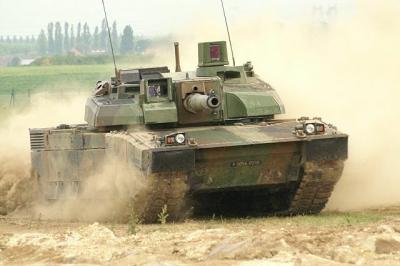The delivery of heavy tanks to Ukraine, in general and Leclerc tanks in particular, is a matter of debate. Firstly, because it could be interpreted as an "escalation" by Moscow. It is not clear what exactly would such an escalation consist in, compared to the already completed delivery of much more sophisticated systems such as the Himars or the Patriots. However, we need not go into that - for in fact, we are only responding, with great delay, to the Russian escalation. It is the Russians who have gone, in less than a year, from a "special operation" to the invasion of a large part of the country, the annexation of Ukrainian regions, the destruction of cities, civilian infrastructures, the assassination of civilians, the deportation of children or the employment of weapons causing radioactive tsunamis. Not to mention their public TVs and leaders who threaten to wipe Britain or France off the map. What the great French experts on the subject, admittedly absolutely brilliant but always wrong, do not seem to understand is that Putin's regime has a scum mentality. That regime only respects and understands force. Remember that at the beginning of the arms deliveries, Moscow threatened the West with the end of the world. And? Nothing. Just an endless list of frightened Western politicians and opinion leaders who crumbled without even being asked by the Russians. The gangsters in power in Moscow like their lavish lives far too much to start a nuclear war. The only real escalation, in my opinion, would be the delivery of nuclear weapons to Ukraine. Escalation is just an excuse for the pseudo-pacifists to prevent the delivery of the weapons needed to defend that country .
Then there is the question of whether France should send Ukraine its Leclerc tanks. For some, this would restore confidence in the Eastern European countries scalded by President Macron's words. Apart from the fact that the above cannot be a priority in itself, the delivery of 50 'light' AMX 10 tanks, which opened the way for other Western countries to send heavy tanks, is, in practical terms, more important than sending fifteen Leclercs. Another argument for sending Leclercs is that it would allow us to prepare our exports for tomorrow. Problem: the Leclerc is no longer produced, so exporting it will be complicated. And that's where the problem lies.
France currently has a little over 200 tanks in service. There would be many more in stock, but it should be noted that our 200 tanks should last us until at least 2040, and more likely 2050. And since we are no longer producing them, those in stock are there to maintain a permanent fleet of about 200 tanks in service. If we draw on these 200 tanks, this will inevitably lead to a drastic reduction in the envelopes and therefore in the strategic industrial activity of maintenance, modernisation and reconditioning of these tanks. The training hours of French crews on these tanks will also have to be reduced. Moreover, as the Leclerc is the most modern European tank, the learning time for the Ukrainians to evolve in formations of several tanks while optimising all its capabilities will take much longer than with the German Leopard tank. The latter is the most common tank in Europe and the only one that can be delivered in sufficient quantity to meet Ukrainian needs.
So, if we want to send heavy tanks to Ukraine, it would be better for Paris, as well as for Kiev, to buy second-hand Leopards which were really designed to respond to the clash with the Soviet army) from countries that are equipped with them (such as Switzerland, Turkey, Indonesia, Singapore or Qatar). In order to make this as useful as possible for our troops, we could even imagine joint training on these tanks. Our technicians could go to the Polish and Czech maintenance workshops to see how they prepare 3-4 brand new tanks out of 5 stunted ones before sending them to the front, and then repair those that return from the Ukrainian front.
France is beginning to have far too many "holes in the racket" to get rid of its Leclercs. Especially since, while waiting for the Polish army to become the first land army in Europe, we are the last army on the continent to be really operational. Some will say that this is true, but why? It's simple - since the fall of the USSR we have never faced so many risks. If tomorrow China and North Korea ally themselves with Russia and impose a general blockade on South-East Asia, and if Iran blocks the Strait of Hormuz, the Americans will have no choice but to intervene and all their projection capabilities will be used. Europe will then be left alone against the Russians who are now able to control all the African migration corridors and trigger migratory tsunamis in the Mediterranean. The attacks on the Polish border by Belarus, using migrants in 2021, show us that this is not a science fiction scenario. A confrontation between Algeria, a Russian ally, and Morocco, a US ally, cannot be excluded. All this would cut us off from Algerian and Qatari gas. We could therefore be forced to intervene on the southern flank while defending ourselves on the eastern flank of Europe.
So rather than thinking about whether we should send Leclerc tanks, it would be better to think about how to provide us with more tanks. We could do like the Poles and buy Korean K2 tanks (as modern as the Leclerc) which are immediately available. But we would once again plummet our industrial tool which is withering away. However, we will need them if Asia is no longer accessible tomorrow. It is important to know that 1000 tanks throughout Europe will have to be replaced before 2030. Also, the Franco-German "tank of the future" programme, which will not be able to offer an operational tank before 2045, will come too late. The usefulness of clinging to that programme is all the more questionable when we observe what is happening in Ukraine. On the ground, faced with modern Western weapons (which, because of their exorbitant cost, can only be deployed in small quantities), the Russians are saturating the battlefield with obsolete men and equipment in order to overwhelm the Ukrainians and exhaust their resources. We can see that the Russians are technologically outdated, so why should we want to make an even more modern tank, which will be even more expensive than the Leclerc and which we will therefore have to be produced in very limited numbers. As a caricature, in one generation our army will be made up of 10 planes of the future and 50 tanks of the future which will face 5000 obsolete planes and 10 000 tanks of Soviet design. It will soon be enough for our enemies to eliminate our 10 pilots and 50 tank drivers or take their families hostage to win the war.
For all these reasons, we urgently need to reindustrialise on a massive scale and in a forced march. In this context, why not reopen the production lines of the Leclerc, or better, to immediately give the budgets to the Franco-German group KNDS (KMW plus NEXTER Defense Systems) to put into production its technological demonstrator "Enhanced Main Battle Tank" (EMBT). It combines the best of the Leopard (its chassis) and the best of the Leclerc (its turret). EMBT could quickly become the new standard for European armies and benefit from numerous orders. More generally, in view of the risks and the lessons learned from the Ukrainian battlefield, it is better to have massed armaments today than "future programmes" in 20 years' time.
Read also
France: a chimerical rule of law that undermines the credibility of the State and delegitimizes the law
Once again, a professor - Dominique Bernard - has been murdered. Once again, the perpetrator had no business to be in France and should have been deported long ago.
Patrick Edery
France: Are the scandals of the "Progressive Circus" premeditated?
In my editorial of 11 June (LINK), I began telling you about the 'Progressive Circus' to explain the passivity of the French people in the face of the incredible hypocrisy of their ruling elites.
Patrick Edery
Towards a 3rd World War or a 2nd Cold War?
It seems increasingly difficult to deny Huntington's claim about the clash of civilisations.












Comments (0)